Content
- 1 The best varieties of red early raspberries
- 2 What are the most productive varieties of late raspberries
- 3 The best new varieties of large-fruited remontant raspberries
- 4 What are the varieties of yellow raspberries
- 5 The best remontant varieties of raspberries
- 6 The best classic raspberries
- 7 The best standard raspberry varieties
- 8 Productivity of new varieties of raspberries
- 9 Large-fruited novelties and not so
- 10 Bryansk marvel
- 11 Hercules
- 12 Hussar
- 13 Yellow giant
- 14 Giant
Among them, gardeners can choose the best to their taste: early or late, high-yielding or remontant, with berries of red, yellow and even black. Find out which raspberry varieties are most popular in hobby gardening.
The best varieties of red early raspberries
"Balm". Slightly spreading bush, medium height, medium shoot-forming ability. The berries of this early raspberry variety are conical, dark raspberry with slight pubescence, sweet and sour taste with aroma.
"Modest". The bush is medium, slightly spreading. Berries are hemispherical, dark raspberry color, sweet and sour taste, no aroma.
"Companion". The bush is erect, high. The berries of this are one of the earliest varieties of hemispherical raspberries, dark raspberry color, sweet and sour taste.
"Crane". Variety of medium early ripening, remontant. Slightly spreading bush, erect, powerful shoots. Berries are large, conical, raspberry, sweet and sour taste with aroma.
"Hussar". The bush is tall, powerful, does not need support, there is little overgrowth. This is one of the best early raspberries with elongated ruby red berries, sweet and sour taste and amazing aroma.
"Sun". The berries are large, round-conical, crimson in color with delicate fragrant pulp.
"Patricia" - the most interesting among large-fruited raspberry varieties with attractive, beautiful berries. The berries are large, individual up to 14 g, truncated-conical in shape, with a beautiful velvety surface, of medium density, they are removed from the fruit plant without breaking, when fully ripe they do not crumble for a long time. The taste of berries is sweet with a pleasant "raspberry" aroma, juicy melting pulp and a few small seeds. Productivity of 4-5 kg per bush. Fruiting annually, early ripening variety. One of the most productive varieties. Plants are medium-sized (up to 1.8 m), non-repaired, semi-sprawling, annually form 6-10 replacement shoots and 5-7 root suckers.
"Maroseyka" - the first domestic thornless variety with very large berries (up to 12 g) and high yield (4-5 kg per bush). Some of the red berries of this raspberry variety are double, conical. The taste of berries is sweet with a pleasant aroma. Fruiting annually, medium-early ripening variety. Bushes about 1.5 m tall, spreading, powerfully developed, not repaired.
"Aboriginal" - an early variety for areas of the non-chernozem zone. Differs in high yield, large (4-8 g) bright red berries. The berries are conical, well-formed, easily removed from the fruit-bearing.
What are the most productive varieties of late raspberries
Below it is described which varieties of late raspberries are the most productive, and therefore are most popular.
"Brigantine". Berries are dark raspberry, dense, round-conical in shape, good taste.
"Tarusa" - the first domestic variety with standard-type shoots, strongly thickened, hard and tough. Bushes practically do not require supports, but still the harvest is better obtained with a trellis. The berries of this fruitful variety of raspberries are large (up to 12 g), blunt-conical, bright red in color, shiny, well removed from the fruit-bearing. The taste of berries is sweet with a pleasant raspberry aroma. Productivity of 3-4 kg per bush.The bushes of this variety are of medium height (about 1.5 m), compressed type, powerfully developed, non-repairable, form 8-10 replacement shoots and 4-5 root suckers each, do not creep over the site.
"Arbat" - among the new large-fruited varieties of raspberries, it stands out for the abundance of very large berries weighing 15-18 g and more. The berries are elongated and conical, dark red in color, shiny, removed from the fruit plant without breaking. The taste of berries is sweet with a pleasant raspberry aroma, juicy melting pulp. Productivity - up to 9 kg per bush. Plants of this one of the most productive varieties of raspberries are medium-sized (1.5-2, Ohm in height), spreading, powerfully developed, non-repairable.
"Hercules". This variety of raspberries has a medium-sized and slightly spreading bush, shoots are strong, upright, you can do without trellises when growing. Annual shoots are green in spring, and by autumn they acquire a purple hue with a waxy bloom. The thorns are hard, thin and prickly. Autumn harvest in the middle lane reaches 1.5 kg per bush. The first fruits appear on the bushes in early August. Fruiting lasts until the first frost. The fruits of this variety are very large, the average weight of one berry is 5 g, the maximum reaches 10 g. The berries have a truncated-conical shape. The color of the berry is ruby, the taste is sweet and sour.
"Daughter of Hercules". A high-yielding variety with very large tasty berries, weighing 8-10 g. Individual berries reach a weight of 20 g.
As you can see in the photo, this stock of raspberries has berries of an elongated-blunt-conical shape, dense, well-transportable:
The bush is medium-sized, the shoots are highly branched. Requires little support.
"Firebird". Large-fruited, high-yielding variety with bright red berries. A distinctive feature is high drought resistance and heat resistance.
"Calendar". This variety is sometimes called the "raspberry tree" for its powerful shoots and bush in general. Do not creep over the site. Recommended for growing in all horticultural zones of the European part of Russia.
"Beauty of Russia". It bears fruit with a very tasty berry and has an early ripening period. Berry weighing up to 12 g. This one of the best varieties of raspberries has a smooth trunk and bears fruit well in a sunny area, does not like thickening. Highly productive with good care. These berries can not only be eaten from the bush, they can be admired.
"Stolichnaya" - a late variety of raspberries, high-yielding, distinguished by powerful shoots without thorns. The berries are large (4-8 g), homogeneous, well removed from the fruit plant. When ripe, 3-4 days do not crumble.
The best new varieties of large-fruited remontant raspberries
Here you can find photos and descriptions of remontant type raspberry varieties.
"Indian summer". The first domestic cultivar of remontant raspberry with predominant fruiting on annual shoots.
"Apricot". Amber fruits with a pink blush have an apricot flavor. Such amazing berries delight not only children, but also seasoned adults. This raspberry begins to ripen in August and bears fruit until frost. During the summer-autumn period of fruiting, gardeners manage to collect up to 4 kg of berries. Semi-spreading bushes, medium height. Thorns are located mainly in the lower part of the shoots, so they do not interfere with caring for the plant and harvesting at all.
"Bryansk Marvel". The variety of this raspberry has a medium-sized and compact bush, which reaches a height of 1.6 m. Fruiting is abundant, fruits are large, up to 6 g. The berries have a graceful elongated-conical shape with a pleasant taste and delicate aroma. They separate well from the stalk. Up to 5 kg of raspberries are harvested from the bush. The first crop is harvested in July, and the second - from mid-August until the first frost.
"Taganka" - early variety, high-yielding, large-fruited. Numerous thorns on the shoots. The berries are large (4-8 g), conical. The grade is remontant. The berries of the autumn harvest are also very large (up to 6 g).
"Kalashnik" - a remontant variety, which is used exclusively for obtaining an autumn harvest.
"Pride of Russia". This one of the best varieties of remontant raspberry is distinguished by its large and attractive berries. Weight reaches 12 g, individual berries can reach 18 g. Fruits have a conical and blunt-conical shape with a velvety surface. The berries are easily removed from the stalk and, when fully ripe, do not crumble.
The taste is sweet, light and pleasant aroma. The berries are juicy and have small seeds. Up to 5 kg of fruits are harvested from each bush. Bears fruit every year. The variety ripens on July 8-10, therefore it is considered medium early. The bush of this variety is medium-sized and compact. The variety is not remontant.
"Cap of Monomakh". The variety is remontant, has a low bush in the form of a small tree, which forms several slightly drooping, highly branched shoots. The variety is distinguished by large fruits (up to 7 g) of ruby color, elongated blunt-conical shape. The berries come off well from the stalk, ripen in mid-August and bear fruit for a long time. You can collect 5.5 kg of berries from a bush. However, before the first frost, not all berries have time to ripen. The first crop is harvested in July, the second from mid-August until the first frost.
"Giant" considered one of the best varieties for cultivation in summer cottages. This is a new variety of raspberries that has a distinctive feature: it lacks thorns. The weight of the fruits of this one of the best varieties of large-fruited raspberries can be 25 g. The yield of one bush reaches 12 kg, of course, subject to all the rules of agricultural technology.
Atlant - one of the best varieties of remontant raspberries with very tasty and aromatic berries. Moreover, even cold and rainy weather does not negatively affect the taste of the berries. The first berries ripen in mid-August, and then the yield goes very quickly. By mid-September, up to 5 kg of fruit can be harvested from one bush with good care.
"August miracle" - remontant raspberry variety forms a low compact bush, consisting of 7-8 upright shoots. The berries are formed almost along the entire length of the shoot, large, weighing up to 4 g, excellent taste with a delicate aroma. High productivity - 4 kg per bush.
"Penguin". The variety got its name for the standard type of bush. Strong shoots with shortened internodes, does not require additional support (bush height 1.1-1.4 m). The variety is remontant, fruitful, one of the earliest ripening, until mid-September the harvest has time to ripen completely. The berries are large, 6-8 g, round-conical, dark crimson. After ripening, they can hang on the bush for 5-6 days without decaying.
"Eurasia". A variety with a ripening period in the first decade of August. Large berries with good taste. Raspberry-like fruiting of medium vigor.
What are the varieties of yellow raspberries
"Orange miracle". This remontant variety has large berries (10-12 g) of golden yellow color and elongated conical shape. The bush reaches a height of 1.6 meters. The thorns are soft and short. The bush of this yellow raspberry variety does not require support. The variety is high-yielding, which is usually not characteristic of yellow-fruited varieties.
"Golden autumn". Large-fruited, remontant variety with bright golden yellow berries. The berries are large, 5-7 g, individual up to 11 g, beautiful, elongated-conical, dense. Dessert-flavored berries with a persistent raspberry aroma. The yield is high. Resistant to diseases and pests.
"Yellow Miracle". Exceptionally productive remont variety, with large (6-8 g) yellow berries, Good dessert taste. The variety is vigorous, the shoots are thick and strong, but requires support. Differs in late onset of autumn fruiting (first decade of September). It is best used as a variety combining summer and autumn harvests.
"Yellow giant" considered the largest among all raspberry varieties. The sweet fruit reaches the size of a walnut. The bushes grow crowded, up to 2.5 m in height. In the fall, the upper part of each shoot is cut off at a height of two meters.With this technique, you can achieve the formation of larger fruits. The shoots are strengthened on a trellis.
Now watch the video "Raspberry Varieties" to get a better idea of what shrubs and berries look like:
Review of the best varieties of the sweetest raspberries according to gardeners' reviews
Raspberries are a popular and healthy summer berry. Old adapted varieties in Central Russia are distinguished by their unpretentiousness and vitality. On the site, raspberries can even behave aggressively, capturing new territories and expanding the boundaries of the raspberry. This behavior is due to the characteristics of the varieties and lack of care. The best varieties of raspberries according to reviews of gardeners from different regions are presented in our rating.
Raspberry varieties are conventionally divided into 4 groups: large-fruited, classic, renovation and standard (tree-like).
Large-fruited raspberry inherited from the parental forms a high mass of berries and low winter hardiness. When growing large-fruited varieties of raspberries in the Middle Lane, the shoots are bent down and covered for the winter. To obtain large berries, you will need to create the appropriate conditions: the introduction of organic matter, top dressing, prevention of diseases and pests, regular watering. On poor soils, you cannot get a good harvest, and in a drought the berries will simply dry out on the branches. The brightest representative of the group, which has many fans and is grown even in the Urals - Krasa Rossii.
Stock raspberrydespite the growing interest in the group, it remains exotic in Russian gardens. These varieties of raspberries are decorative, easy to pick berries, disease resistance and high yield (due to active lateral branching). "Raspberry tree" does not need support, the crown retains its shape under the weight of the berries. At the same time, the varieties show good frost resistance and unpretentious care. Formation consists in pinching the tops of the shoots by 10 - 15 cm. In this group, the Tarusa variety is distinguished.
Classic raspberry varieties bear fruit on the shoots of last year, so the ripening of the berries begins early: from the end of June to July. Bushes winter with long shoots, which are recommended to be covered in the conditions of the Moscow region.
Repair raspberry bears fruit on both last year's and young shoots. But experienced gardeners recommend cutting out all the shoots in the winter and getting one late harvest on a young growth. In this case, the yield will be higher and the size of the berries will be larger. Fruiting period for remontant varieties: from late July to September-October. Many varieties of remontant raspberries are well suited for the Moscow region. Their advantages: they winter without problems, do not suffer from pests, and are superior in yield.
The choice of the best raspberry variety also depends on the purpose of the raspberry planting: for home use of dessert berries or for the sale of a marketable crop. Commercial varieties are distinguished by high yields, transportability and attractiveness of berries, but inferior in taste.
The best raspberry varieties according to gardeners' reviews
The best remontant varieties of raspberries
|
Polka 250 (for one year old seedling in a bag with wet moss) A remontant dessert variety of Polish selection. Sprawling bush, 1.6 - 1.8 m high, forms little root growth, gives up to 10 replacement shoots. Shoots are strong, do not bend during fruiting, covered with small, thornless thorns. The berries are dark red, rounded-oblong, with an average weight of 5-6 g, sweet taste, with a pronounced bright aroma, well stored and transported. The yield of one bush, with proper care, exceeds 4 kg. Berries do not crumble, are transported, due to dry separation, they are ideal in freezing. Shows high resistance to gray rot and spider mites, but susceptible to cancer of the measles system. It has low winter hardiness, but with complete mowing of shoots, this disadvantage is not of paramount importance. In arid climates, it behaves badly. This remontant variety of raspberries received good reviews from gardeners in the Rostov region and the Moscow region. Main pluses:
Minuses:
|
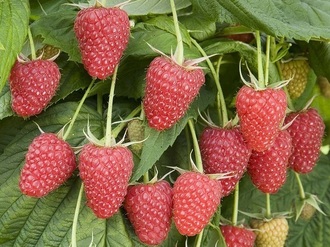 9.8 / 10 Rating Reviews The most delicious berry of remontant. In areas with harsh winters better to cut off flush with the ground and mulch well.
|
|
Bryansk marvel 270 (for a one-year seedling in a package with moist moss) Repaired raspberry variety for commercial purposes and personal use. It is late in terms of ripening. The bush height of 1.5 - 1.9 m, slaboraskidisty, the formation of secondary shoots. Key thick shoots with a few soft spines, thorns on the branches of fruit available. Garter do just windy areas. Also, due to the long side shoots garter provetrivaemosti and promotes better illumination of the lower tier. Berries classic red, cylindrical, elongated, a length of 3 - 4 cm, a weight of 5 - 7 and 11 - 20 The average yield - 3 kg per bush. The taste is sweet with sourness. Evaluation of palatability good and excellent. Berries dense, well-kept and transferred to transportation. Bush had to realize yield potential, the lower buds are removed, accelerating the maturation of the upper and contributing to the formation of larger berries. It prefers light fertile soil, heavy loam sharply reduced yields. Winter hardiness is medium. In the winter recommend shoots mowed to the ground, as the stump left takes power from the roots and reduces winter hardiness. Grade bad manifests itself in arid regions. Recommended for Moscow and Central bands. Main pluses:
Minuses:
|
 9.7 / 10 Rating Reviews This sort of fond of raspberries ripening later, when some apples left in the garden. With good care and proper fit is no problem with it.
|
|
Orange miracle 250 (per seedling annual package wet moss) Repaired variety with orange berries. Scrub Average height, 1.7 m in height and compact. Shoots erect, heavily covered with spines, brittle and may break off under the weight of berries. Education fruit twigs active and covers 2/3 of the length of the shoot. Bush is shaping up to 7 shoots of substitution and give a lot of shoots. The berries are cone-shaped, with a slightly pointed apex, dense, even, up to 4 cm long and weighing 6 - 12 g. They have a delicate aroma and sweet taste with a slight sourness. The sugar content depends on the soil and climatic conditions of cultivation and the level of farming. Berries are well transported, at overripening remain on the branches. The yield from one bush reaches 3 kg, while before frost the variety manages to give 70 - 100% of the potential yield. There is a high resistance to pests and medium - to disease. Dessert taste of berries and make good transportability grade universal. The variety is well in Moscow and Rostov regions, is recommended for the middle lane of the Urals and Western Siberia. When grown in culture, annual (truncation in the winter on a tree stump) there is no risk of freezing of shoots. Main pluses:
Minuses:
|
 9.7 / 10 Rating Reviews The best variety of raspberry remontant for the suburbs, in my opinion. Berry delicious and very beautiful, matures quickly. If you break the unripe berries along with the stem, they ripen perfectly.
|
|
Hercules 450 (2-year-old seedling in the container) Remontant variety of commercial applications. Shrub 1,6 - 1,8 m. Shoots erect, rigid with spikes on its entire length, durable and do not require support. Lateral profuse branching, shoot formation weak (up to 3 - 4 substitution shoots). The variety is resistant to dense plantation, does not require frequent thinning. Berries ruby, frustoconical, dense, weighing from 6 - 10 to 15 g, with a pronounced aroma.The taste is sweet and sour, refreshing, but in cold weather the sourness is more pronounced. The yield from one bush reaches 4 kg. Differs in high resistance to diseases (including viral) and pests, drought-resistant and winter-hardy. Waterlogging spoils the taste of the berry, making it watery. With a lack of heat and lighting during the ripening period, the berries are sour, they are good in compotes and jam. This variety of raspberries has adapted well in the Moscow region, the Middle Belt and the Urals, showing stability and unpretentiousness. In regions with cold rains in the second half of summer, it is impossible to get a high-quality berry without additional measures. Main pluses:
Minuses:
|
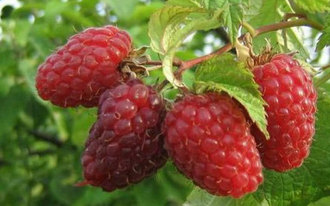 9.5 / 10 Rating Reviews For beginners, this raspberry is the easiest to care for in comparison with other remontant varieties, top dressing and a well-chosen site, it is possible to get delicious berries.
|
|
Firebird 220 (for one year old seedling in a bag with wet moss) Repaired grade for small areas. Gardeners appreciate it for its excellent taste. In terms of yield, transportability and size it loses to other commercial varieties. More often grown for personal use. The bushes are compact, up to 2 m high, forming 5 - 8 replacement shoots. Shoots are covered with soft and thin thorns, to a lesser extent on the upper part. A garter to the trellis is required. Bright red berries of a conical shape with a blunt top, glossy, drupes are large, dense, weighing 4 - 6 g. The yield per bush is 2 - 2.5 kg. Ripe berry does not crumble. If the berries are picked regularly, avoiding overripening, then the harvest is well transported. This raspberry shows good results in the southern regions, but due to insufficient heat resistance it needs mulching and shading. In the northern regions, it manages to realize only 70% of the potential yield. Main pluses:
Minuses:
|
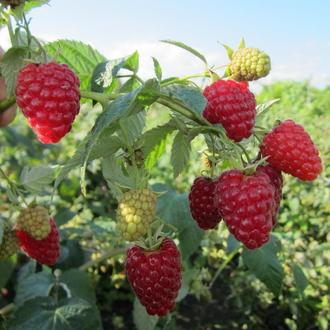 9.5 / 10 Rating Reviews An excellent dessert berry, it does not prick strongly, so the collection of berries is without negative. The care is the same as for other remontant raspberries.
|
The best classic raspberries
|
Kuzmin's news 250 (for one year old seedling in a bag with wet moss) An old classic mid-season raspberry variety that does not lose its popularity. Grown for fresh consumption and processing, not suitable for commercial purposes. The bushes are tall, from 2 to 2.5 m, erect, slightly spreading, they form few root suckers. Gives few replacement shoots. Shoots are arched, drooping. Thorns are long and thin (shorter and thicker towards the apex), cover all shoots, but their number is average. The berries are oblong, dyed red, with an average weight of 2 - 5 g, with a weak aroma. The taste is excellent, but the berries are not suitable for transportation and storage. When ripe, they are easily separated from the stalk, but when overripe, they do not crumble. On average, 1.5 - 2 kg can be harvested from one bush. In favorable years, repeated fruiting is possible on young shoots. The variety is not picky about soil types and care, but has a low drought tolerance. In the absence of watering, the beginning of fruiting is delayed by 2 - 3 weeks. Poorly tolerates drafts and is susceptible to viral diseases. In general, the variety is characterized as the most hardy and is recommended for "lazy" and inexperienced gardeners. It is grown in all regions of Russia, but is of particular value for the Central belt, the Urals and Western Siberia. Main pluses:
Minuses:
|
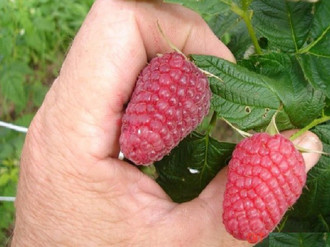 9.5 / 10 Rating Reviews The best raspberry variety for Siberia, for fresh consumption.I have 2 bushes planted especially for children. The overgrowth does not torment, I also don’t fiddle with shelter.
|
|
Yellow giant 300 (for one year old seedling in a bag with wet moss) A classic variety of early ripening yellow raspberries. The bush is powerful, 2 - 2.3 m high. 8 - 10 replacement shoots are formed, but the bush remains compact and does not fall apart. Young shoots without thorns, on old ones - in small numbers. It is prone to strong branching of fruit branches: up to 4 - 5 orders of magnitude. Intensive development of root growth. The main fruiting is on last year's shoots, but under favorable conditions, a second wave of fruiting is possible at the tops of the young growth. Amber-yellow years are broadly conical with a blunt apex, up to 4 cm long and weighing 8 - 10 g. The yield from one bush is more than 4 kg. Due to poor transportability, they are used only for personal use. In the middle lane, it shows insufficient winter hardiness and requires additional protection. Shoots are flexible and bend easily for winter shelter. Main pluses:
Minuses:
|
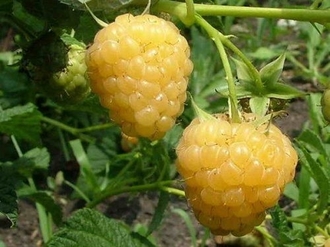 9.5 / 10 Rating Reviews I keep several bushes of this raspberry as a treat. The variety is appreciated for its excellent taste and beautiful berry. Not suitable for sale, processing and freezing.
|
|
Patricia 200 (for one year old seedling in a bag with wet moss) A classic variety of large-fruited raspberries. Spreading bush, 1.5 - 1.8 m high, annually gives 6 - 10 replacement shoots. Forms a lot of root growth, which should be removed in a timely manner. A garter to the trellis is required. Shoots of the first year without thorns. At the end of the season, formative pruning of the shoots is required. Fruiting begins in mid-June and lasts until mid-August. The berries are bright red, cylindrical or irregular in shape, with a velvety bloom, with an average weight of 5 - 6 g (up to 10 - 12 g). Drupes are large, fit tightly. The aroma is pronounced. The average yield is 4 - 5 kg per bush, but can reach 8 kg. The berries do not tolerate transportation well and are not intended for long-term storage. The variety does not tolerate waterlogging. Recommended for the Central region of Russia, but successfully grown in the Urals. Main pluses:
Minuses:
|
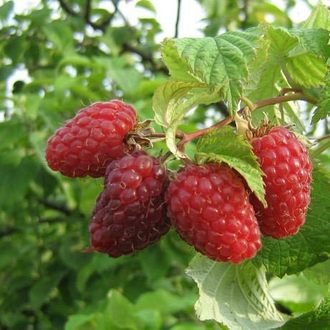 9.4 / 10 Rating Reviews Berries with a very delicate pulp, ideally: pick and eat immediately. With the harvest, raspberries cannot be postponed - overripe berries mold and crumble.
|
The best standard raspberry varieties
|
Tarusa 300 (for one year old seedling in a bag with wet moss) Standard raspberry with late ripening. In one season, a branchy tree grows up to 1.8 m high, with thick shoots on a trunk. Shoots are elastic and do not need a garter, there are no thorns. The variety branches beautifully and does not need special labor-intensive pruning. Gives 3 - 4 replacement shoots annually. No more than 10 shoots are left in the bush. Berries are burgundy-red, sweet and sour, conical or irregular, up to 10 - 15 g, dense and transportable, have a pronounced aroma and are good for processing. Small seeds are almost not felt. Productivity is high: up to 4 kg per bush. Despite the high declared winter hardiness, freezing is observed in the windy area in snowless winters. Grown from the Moscow region to the Urals. In rainy summers, the berries are watery and sour. The taste is strongly influenced by grooming and feeding. Main pluses:
Minuses:
|
 9.7 / 10 Rating Reviews The shoots at Tarusa are powerful, but under the weight of the crop they still sag and can break, so I use a trellis. Good yield, we use it for making jam and jam - it turns out very fragrant.
|
|
Monomakh's hat 270 (for a one year old seedling with a bag of wet moss) Standard raspberry variety with remontant fruiting. The bush is up to 1.5 m high, forms up to 5 powerful branched shoots with drooping tops. The lower part of the shoots has hard thorns. Due to the weak formation of shoots, cuttings are more often used for reproduction. Berries of juicy red color, weighing from 7 to 20 g, pyramidal with a blunt top, sweet with a slight sourness and bright aroma, leveled and mouth-watering. When assembled, they do not fall apart, are suitable for storage and transportation. An average of 4 - 5 kg is harvested from one bush. Reacts painfully to interruptions in watering, tying small berries. The variety has an average winter hardiness. In the northern regions, under conditions of early frosts due to late ripening and extended fruiting, it realizes only 50% of the potential yield. This raspberry variety is good for the southern regions. In the middle lane, it is grown in an annual crop, when in autumn the shoots are cut to ground level. Main pluses:
Minuses:
|
 9.3 / 10 Rating Reviews Dessert-tasting berries, neat, fruitful bushes. Raspberries require attention, but this is for all large-fruited varieties.
|
Studying the varietal diversity in the catalogs of online stores or nurseries, one should not forget about acclimatization and varietal testing in new climatic conditions for the variety. If the raspberry variety seems attractive to you and has positive reviews in other regions, then first you should buy 1 - 2 bushes, provide them with better conditions and conduct your own assessment. The taste, the strength of growth, the ripening period are largely determined by the growing conditions: the climatic zone and agricultural technology.
Have a nice harvest!
Attention! The reliability of the information and the results of the ratings is subjective and does not constitute advertising.
Productivity of new varieties of raspberries
The first selection criterion is yield. When the engine of progress tells us about catastrophically huge numbers - up to 50-60 t / ha, we believe. Some due to naivety, some due to other circumstances - but we believe. Not all, but many. How much productivity can you expect, which is considered excellent, and which is minimal?
On average, if you take a modern high-yield variety, you can count on 15-20 t / ha in industrial culture, 3-5 and up to 8 kg per bush, depending on the photoperiodic type - traditional or remontant, in amateur gardening.
Old, fruiting mainly on the tops of the shoots - by this time we will return, give an average of 1.5-2 kg per bush.
Which ones are considered the most productive today?
- Most of these are varieties of Polish selection, presented by the Institute of Horticulture and Floriculture in Brzezna, Jan Danek, originally from the UK, samples of the Glen series belonging to the Scottish breeding program, among which are thornless Glen Prosen, Glen Moy, as well as breeding institute East Malling, East Mulling experimental station, the oldest and most famous scientific station, Russian Hussars, Hercules, Patricia, etc.
- The American market, more precisely, the North American one, is represented by the products of the breeding programs of the University of Washington and Mary Land, the State University of North Carolina, and the Pacific Research Center for Agricultural Products of Canada.
- Among the common products of the program are American varieties Chemainus, Cowichan, Malant, Qualicum (Canada), Washington Cascade Delight, Cascade Dawn, Cascade Bountu. American renovation works are represented by Californian works of the Driskolsky Partnership, including Isabel, Caroline, Cardinal, Madonna, etc.
 In the photo there are new modern varieties of raspberries - fruiting
In the photo there are new modern varieties of raspberries - fruiting
Among the requirements put forward for the new American forms, light color of fruits, yield, large fruit, a high percentage of sugar and low acid, the absence of a pronounced aroma - which is very curious, and most importantly - resistance to viral infections, root rot.
We will tell you about the yield of the most famous ones below.
Why do we need new items?
This is not a tribute to fashion - the yield of modern new varieties of raspberries is many times greater. In addition to the larger size, productivity, the absence of thorns in many, or the presence of a slight stud, there are a number of advantages.
- Firstly, fruit branches are located along the entire length of the shoot, starting from a height of 25-30 cm from the ground in many. Secondly, many new items are tall, due to which the number of laterals and fruits increases. In addition, the abundant branching of plants allows not only to take off high yields, but also to relieve oneself of the labor of pruning, i.e. pinching the tops and side branches to stimulate branching.
- The higher resistance to diseases of many new products makes it necessary to get rid of old ones, to look for worthy alternatives.
- So, they are quite resistant to major viral diseases, dwarfism, overgrowth, and are resistant to damage by pests.
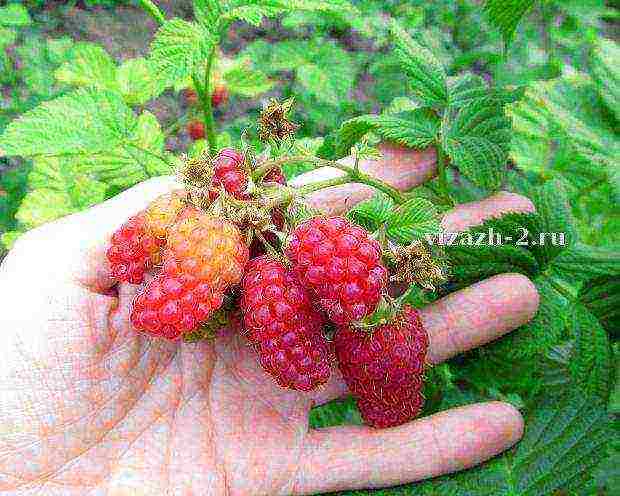
Early-late - pay off!
The timing of fruiting is another primary criterion for choosing a new modern variety specifically for you. Among the novelties of European, Russian selection there is something to look at.
The early ones are from European Laszka, Malling Minevra, Glen Moy, Mallig Jewel, Promis.
Main season (mid-early) from Russian Hussars, Pride of Russia, from European Glen Ample, Glen Prosen, Malling Admiral, East Malling.
Late-Main Season: Glen Fain, Glen Doll, Tulameen, Cascade Delight.
Late: Glen Magna, Malling Hestia, Octavia, Tadmor.
Repaired - fruiting in the fall on the shoots of the current year: the Russian Hercules, Taganka, the famous Polish Polana, Pokusa, Polka, the English Himbo Top, Joan J, Autumn Treasure, Autumn Bliss, as well as the Swiss Sugana, Erika.

Do not let the reader be confused by the above list, which contains most of the foreign names.
Russian selection, in spite of everything, does not stand still. New varieties of Russia, bred in the next 5-6 years: you can call Beglyanka - bred in 2009, Prelest - 2010, Arbat, Patricia, Giant, Ozarenie, Orange Miracle, Penguin, Berdskaya, Nadezhda, Student, etc.
Ukrainian breeding is also developing, albeit not by leaps and bounds. Brusvyana is a vivid example of the experience of private selection, when Brusilovskaya, Brusilovskiy standard, Yaroslavna were obtained in the farm of the same name with her. In addition, there is Syaivo, Cosmic, Princess, which should be paid attention to.
Here is a description of some of the most famous and noteworthy.
Glen Ample is an ideal modern industrial grade: yield up to 200 c / ha, unpretentious, productive. Obtained by crossing Prosen x Meeker. Fruits are dense, large, weighing from 6 to 8 g, in average weight up to 4-5 g, bright red, with a pronounced raspberry aroma. Drought resistance, winter hardiness 9 points, disease resistance 8 points, transportability 9 points.
Malling Minevra, East Malling Yield Product. With a dark red berry of excellent taste, sweet and aromatic, long-term storage Features - early fruiting, resistance to the group of diseases carried by the RBDV virus.
Tulamine - its light berries with a pronounced shine of a conical shape are not to be confused with. The standard for Western Europe, it is distinguished by its high taste, cancellation productivity and transportability.
Cascade Delight, bred in the USA, recommended for industrial cultivation, suitable for mechanized harvesting, hobby gardens. Heat-resistant, resistant to diseases of the root system, making it possible to grow in a damp, cool climate with an abundance of rainfall.
Glen Magna is another of the Glen dynasty, the fruiting period is longer compared to Glen Ampl. Fruits are large, cone-shaped, dense, fleshy, well transported. In Scotland, it gives up to 11 t / ha, maximum up to
Octavia, bred at the East Malling Institute, UK, is considered one of the promising varieties of medium-late fruiting. Yields up to 25 t / ha with intensive farming, more than 3 kg per bush.Perfectly transported, amenable to storage.
Lyachka by Jan Danek, a product of the famous Polish Brzezn Institute, which has given the world a lot of finds. Early maturation, not remontant. Almost ideal: tasting assessment, frost resistance and drought resistance, transportability - 9 points. Productivity 170-200 c / ha.
Himbo Top comes from Switzerland, remontant, large-fruited, dense, fleshy fruits weigh up to 10 g, tall - requires support. Productivity is about 3 kg per bush. Autumn fruiting (extended, 6-8 weeks) begins in mid-August, a couple of days after Polka.
Autumn Treasure is late-ripening, stems without thorns, peak fruiting in August-mid-September. Light red, tasty, dense berries are concentrated mostly in the upper part of the shoot, medium and large in size from 3 to 5 g.
Polka is another novelty from Brzezn. Fruiting late July - early August. Shoots of about 1.5-1.7 m, studded. The berries are large and medium-sized, bright red, elongated. Productivity up to 15 t / ha.
Glade with its rich red berries weighing 3-4 g. Plants are compact, medium-sized, ripen 1-2 weeks earlier than Shelving, 2-3 weeks earlier than Heritage. Productivity up to 20 t / ha.
Hercules bears fruit from mid-August to October. Thorny shoots, 1.5-1.7 m high. Productivity up to 92 c / ha, up to 3 kg per bush. It is not used in industrial production, it is good for small agribusiness, amateur cultivation.
Patricia remontant, medium ripening, in the first decade of July. Resistant to diseases, pests. Productivity 4-8 kg per bush. Good for small-scale production, amateur gardening.
Choice by purpose: position obliges
Choosing a new variety based on soil and climatic conditions is the first commandment of a successful industrialist and gardener. So, new items zoned for Western Europe or the south need shelter in the Central Black Earth region of Russia, they may not fully reveal themselves or show poor survival in the Urals, in Central Russia.
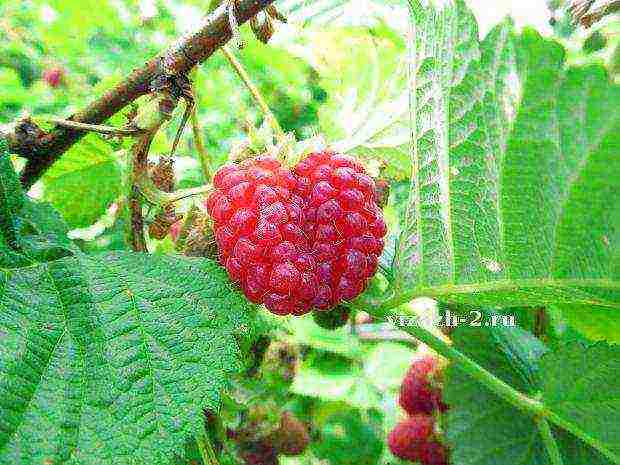 In the photo there are new large-fruited varieties
In the photo there are new large-fruited varieties
When choosing for the Moscow region, it is worth focusing on frost-resistant, medium-early, with a not too extended fruiting phase, which manage to give the berry before early frost.
As an example, we can recommend both domestic - again well-known Hussar, remontant Taganka, Patricia, and European - Polka, Glen Ample, Glen Fine.
If you rely on the information of the State Register of the Russian Federation, suitable old and new for the Non-Chernozem zone, where 27 names are zoned, including Novost Kuzmina, Barnaulskaya, Kostigbrodskaya, Novokitaevskaya, Kaliningradskaya. Some of them are outdated, some still delight with the harvest.
For the Central Region of the Non-Black Earth Zone, the irrigated areas of the Middle and Lower Volga regions, Arbat, Gusar, Patricia are suitable
For the south of Western Siberia, Altai, Gusar and Giant are suitable.
For the Central Black Earth Region Giant, Gusar, Arbat, Atlant, etc.
It is worth noting that not all new items take root well; in regions of risky farming for culture, it is worth paying attention to old, proven friends who can easily endure severe winters and an unkind cold spring. It is worth remembering the inability of seedlings from Foggy Albion or relatively warm Poland, which do not take root well in the continental climate - and remember the zoned, viable and adapted ones.
New varieties for Siberia - most often recommended zoned for this region bred in the Research Institute of Horticulture. M.A. Lisavenko. Vera, Brilliant, For Health, Zorenka Altai, Kolokolchik, Rubinovaya and many others - all of them are distinguished by high winter hardiness and frost resistance, amicable ripening in mid-early periods - in mid-July.
For southern Siberia, the Urals, Central Russia, the repairing new I.V. Cossacks, fully adapted to local conditions.Hercules, Cap of Monomakh, Bryansk Marvel, Inaccessible.
If new varieties of raspberries are chosen for Ukraine, you need to keep the course for mid-ripening and late ones, having time to yield before the cold weather, resistant to moisture and drought-resistant and heat-resistant, if for the southern regions. For the northwest - resistant to damp, humid air, root rot. For the Eastern regions of Ukraine, winter-hardy raspberries are suitable due to severe frosts and insufficient snow, drought-resistant, early, medium-early and remontant varieties. Again, let the reader not take it for advertising, remember the above-mentioned products from Jan Danek, the Polish ones - Polka, Lyachka and Polana, remember the European Glen Ample, Glen Fine and others.
Disease resistance
When breeding, special attention is paid to resistance to bacterial, fungal and viral infections, to major diseases. When buying seedlings in a nursery, we can count on in vitro culture, i.e. clean from bacteria, obtained under special conditions, free from pathogens of pathogenic flora. Such planting material is not cheap, but it is worth it: if you are going to breed new raspberries in earnest, want to get your own seedlings, you need pure material, not cheap.
It is worth mentioning that many new products are more resistant to the dwarfism virus, overgrowth carried by leafhoppers, in general, less susceptible to diseases of the root system. By carefully reading the descriptions of varieties from the originator, you can find information about the predisposition of plants to one or another type of disease. So, about the tendency to root diseases Glen Ample, Glen Fine, the originator honestly warns.
By the way, the vaunted Octavia and Tulamin are both sinful with instability to root rot with damp air, heavy clay soil, with warm mild winters. In fairness, it should be noted that in open ground, in areas without dampness, waterlogging is not a problem. Indoors, in greenhouses, with an excess of warm, damp air and a lack of preventive measures, the problem does occur - but not often enough to give up wonderful productive plants.
Large-fruited novelties and not so
You will not surprise gardeners and farmers with a berry weighing 3 g - serve 10! Gigantomania, which has seized the European market, has long settled in our area. So, among the new varieties of large-fruited raspberries, the line of authorship of Kichina - Tarusa, Arbat, Patricia, Taganka, Maroseyka, Penguin, Izobilnaya - there are many worthy ones, a good choice for small-scale production, for amateur gardening. Not all of them are distinguished by excellent taste, not all are suitable for industrial cultivation, but all are worthy of attention.
Most do not participate in industrial cultivation - more precisely, there is no official data, although many of them, remontants, are suitable for machine harvesting. In medium and small agribusiness, many Russian novelties are tested, which are distinguished by their yield, unpretentiousness, and most importantly, suitable for certain climatic and geographical conditions.
European ones are represented by the aforementioned Zyugana, Tulamin, Polka and Polana, Himbo Top, Joan J, etc.
The only disadvantage of large-fruited is the low winter hardiness by Russian standards. This applies to both domestic and English varieties.
It should be noted that for industrial cultivation, a particularly large size is not required: the main thing is stability, gross yield, productivity and suitability for machine assembly. For small-scale production, for farmers and gardeners, the question is relevant: you really want to get rid of small berries, surprise your neighbors with large juicy fruits weighing up to 10-14 g.
End justifies the means?
And finally, when choosing the newest varieties of raspberries, you should not chase the phenomenal yield - believe me, impressive figures are possible only with intensive cultivation technology in most cases.More often you get just enough productive, but not much different from the old-proven ones.
In addition, many new items have not been tested in the climatic conditions of Eastern Europe, many are just a bubble inflated by advertising. Many foreign forms, advertised as a miracle of selection, in fact turned out to be unremarkable samples.
Many did not pass a long test in their homeland, and after a few years they lose varietal qualities - about the problem of the so-called. exaggeration has been known for a long time, as well as about the problem of gullibility of citizens who take advertising at face value. No, this is not a call to use only Russian or Ukrainian raspberries in production or on the site - this is at least not advisable, you can skip extremely interesting options. On the contrary, you need to look for promising samples - but among the proven, well-known, worthy places in the sun of your garden, farm plantation, worthy of our attention. A generous harvest!
Similar materials
- What varieties are best for making money on strawberries
- Me and large-fruited strawberries or what the catalogs won't tell you about
- The downside of the strawberry business
Raspberry is a recognized leader among horticultural crops. Over the long years of her selection, it was possible to bring out high-yielding and unpretentious varieties that have won the love of many summer residents. Want to know more about the preferred varieties?
Raspberries are loved and appreciated for their excellent delicate taste and indescribable aroma of the fruit. Information about the first varieties of raspberries in Russia dates back to the 19th century, and since then gardeners and breeders have been tirelessly working on the creation of new varieties. Let's find out which varieties of raspberries are recognized as the most productive and are guaranteed to give an abundance of berries during the season.
Bryansk marvel
A prestigious remontant variety that begins to bear fruit already in the year of planting. The plant tolerates drought and temperature extremes very well. Berries ripen dense, large, elongated conical shape, saturated red. You will never see wormy ones among them, since the Bryansk diva is not afraid of raspberry beetles and weevils. To make the raspberries grow large, remove the branches with buds at the bottom of the bush until they bloom.
| Appointment | Productivity (kg per bush) | Berry weight (g) | Maturation (period) | Bush height (m) | |
|
4-5 |
6-10 |
1,5-2 |
From mid-August until the first frost |
||
Hercules
Hercules raspberries are sometimes called the "queen of the garden." The bushes are strong, not spreading, erect, do not bend under the weight of the harvest and do not require a garter to the trellis. The plant is rarely attacked by pests and is almost not prone to diseases of gray mold and fungal infection. The berries ripen large, pale burgundy. They are very succulent, so they are best eaten straight from the bush. However, this raspberry jam will suit everyone's taste.
| Appointment | Productivity (kg per bush) | Berry weight (g) | Bush height (m) | Maturation (period) | |
|
3-4 |
9-15 |
1,5-2 |
From mid-August until the first frost |
||
Hussar
This is one of the "golden varieties" of Russian selection, distinguished by unpretentiousness and simple agricultural technology. The plant is also recommended to grow in the southern regions. The berries are large, elongated, with a blunt end. Their color during the ripening period approaches dark ruby. The pulp of the berries is dense, they hardly rot and tolerate long-term storage and transportation well.
| Appointment | Productivity (kg per bush) | Berry weight (g) | Bush height (m) | Maturation (period) | |
|
5-6 |
4-6 |
1,8-2,5 |
Early July - August |
||
Yellow giant
This variety is loved not only for its abundant fruiting and sweet taste of berries, but also for its decorative properties. The bushes are not afraid of frost and common raspberry diseases. It is impossible to store yellow berries for a long time, it is better to eat them fresh, freeze or immediately start up for processing.
| Appointment | Productivity (kg per bush) | Berry weight (g) | Bush height (m) | Maturation (period) | |
|
4-6 |
4-8 |
2,2-2,5 |
Mid July - Mid Autumn |
||
Giant
It is believed that this variety is best suited for summer cottages. There are no thorns on the bushes. The berries have a pleasant taste and aroma of real forest raspberries, they are very juicy and sweet. The plant is not susceptible to attack by aphids and diseases, and also tolerates frost well. Over time, the berries begin to shrink and become similar to regular raspberries. In this case, it is better to plant new bushes.
| Appointment | Productivity (kg per bush) | Berry weight (g) | Bush height (m) | Maturation (period) | |
|
6-10 |
8-14 |
1,2-1,8 |
Mid July - end of August |
||
Choose, compare, experiment! And you will certainly grow raspberry bushes, densely covered with large fragrant berries. Share your impressions and experiences on our forum.


